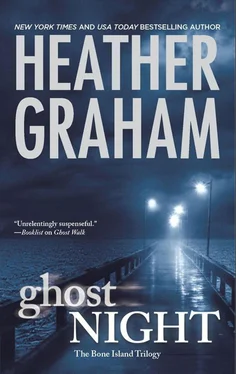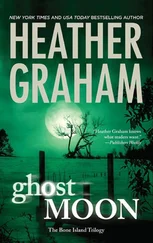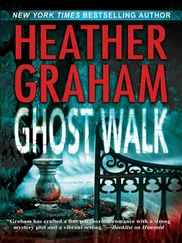Praise for the novels of Heather Graham
“An incredible storyteller.”
— Los Angeles Daily News
“Graham wields a deftly sexy and convincing pen.”
— Publishers Weekly
“If you like mixing a bit of the creepy
with a dash of sinister and spine-chilling reading
with your romance, be sure to read
Heather Graham’s latest…Graham does
a great job of blending just a bit of paranormal
with real, human evil.”
— Miami Herald on Unhallowed Ground
“Eerie and atmospheric, this is not late-night
reading for the squeamish or sensitive.”
— RT Book Reviews on Unhallowed Ground
“The paranormal elements are integral to the
unrelentingly suspenseful plot, the characters are
likable, the romance convincing, and, in the wake of
Hurricane Katrina, Graham’s atmospheric depiction
of a lost city is especially poignant.”
— Booklist on Ghost Walk
“Graham’s rich, balanced thriller
sizzles with equal parts suspense, romance
and the paranormal—all of it nail-biting.”
— Publishers Weekly on The Vision
“Heather Graham will keep you in suspense
until the very end.”
— Literary Times
“Mystery, sex, paranormal events.
What’s not to love?”
— Kirkus on The Death Dealer
Ghost Night
Heather Graham
www.mirabooks.co.uk
For Scott Perry, Josh Perry,
Frasier Nivens, Sheila Clover-English,
Victoria Fraasa, Brian O’Lyaryz
and the great and fun folks
with whom I’ve been on some strange
and entertaining filming expeditions.
NIGHT OF THE WOLVES
HOME IN TIME FOR CHRISTMAS
UNHALLOWED GROUND
DUST TO DUST
NIGHTWALKER
DEADLY GIFT
DEADLY HARVEST
DEADLY NIGHT
THE DEATH DEALER
THE LAST NOEL
THE SÉANCE
BLOOD RED
THE DEAD ROOM
KISS OF DARKNESS
THE VISION
THE ISLAND
GHOST WALK
KILLING KELLY
THE PRESENCE
DEAD ON THE DANCE FLOOR
PICTURE ME DEAD
HAUNTED
HURRICANE BAY
A SEASON OF MIRACLES
NIGHT OF THE BLACKBIRD
NEVER SLEEP WITH STRANGERS
EYES OF FIRE
SLOW BURN
NIGHT HEAT
The Bone Island Trilogy
GHOST SHADOW
GHOST NIGHT
GHOST MOON (September 2010)
Key West History Time Line
1513—Ponce de Leon is thought to be the first European to discover Florida for Spain. His sailors, watching as they pass the southern islands (the Keys), decide that the mangrove roots look like tortured souls and call them “Los Martires,” or the Martyrs.
Circa 1600—Key West begins to appear on European maps and charts. The first explorers came upon the bones of deceased native tribes, and thus the island was called the Island of Bones, or Cayo Hueso.
The Golden Age of Piracy begins as New World ships carry vast treasures through dangerous waters.
1763—The Treaty of Paris gives Florida and Key West to the British and Cuba to the Spanish. The Spanish and Native Americans are forced to leave the Keys and move to Havana. The Spanish, however, claim that the Keys are not part of mainland Florida and are really North Havana. The English say the Keys are a part of Florida. In reality, the dispute is merely a war of words. Hardy souls of many nationalities fish, cut timber, hunt turtles—and avoid pirates—with little restraint from any government.
1783—The Treaty of Paris ends the American Revolution and returns Florida to Spain.
1815—Spain deeds the island of Key West to a loyal Spaniard, Juan Pablo Salas of St. Augustine, Florida.
1819–1922—Florida is ceded to the United States. Salas sells the island to John Simonton for $2,000. Simonton divides the island into four parts, three going to businessmen Whitehead, Fleming and Greene. Cayo Hueso becomes more generally known as Key West.
1822—Simonton convinces the U.S. Navy to come to Key West—the deepwater harbor, which had kept pirates, wreckers and others busy while the land was scarcely developed, would be an incredible asset to the United States. Lieutenant Matthew C. Perry arrives to assess the situation. Perry reports favorably on the strategic military importance but warns the government that the area is filled with unsavory characters—such as pirates.
1823—Captain David Porter is appointed commodore of the West Indies Anti-Pirate Squadron. He takes over ruthlessly, basically putting Key West under martial law. People do not like him. However, starting in 1823, he does begin to put a halt to piracy in the area.
The United States of America is in full control of Key West, which is part of the U.S. Territory of Florida, and colonizing begins in earnest by Americans, though, as always, those Americans come from many places.
Circa 1828—Wrecking becomes an important service in Key West, and much of the island becomes involved in the activity. It’s such big business that over the next twenty years, the island becomes one of the richest per capita areas in the United States. In the minds of some, a new kind of piracy has replaced the old. Although wrecking and salvage are licensed and legal, many a ship is lured to its doom by less than scrupulous businessmen.
1845—Florida becomes a state. Construction begins on a fort to protect Key West.
1846—Construction of Fort Jefferson begins in the Dry Tortugas.
1850—The fort on the island of Key West is named after President Zachary Taylor.
New lighthouses bring about the end of the golden age of wrecking.
1861—January 10, Florida secedes from the Union. Fort Zachary Taylor is staunchly held in Union hands and helps defeat the Confederate Navy and control the movement of blockade-runners during the war. Key West remains a divided city throughout the Great Conflict. Construction begins on the East and West Martello Towers, which will serve as supply depots. The salt ponds of Key West supply both sides.
1865—The War of Northern Aggression comes to an end with the surrender of Lee at Appomattox Courthouse. Salvage of blockade runners comes to an end.
Dr. Samuel Mudd, deemed guilty of conspiracy for setting John Wilkes Booth’s broken leg after Lincoln’s assassination, is incarcerated at Fort Jefferson, the Dry Tortugas.
As salt and salvage industries come to an end, cigar making becomes a major business. The Keys are filled with Cuban cigar makers following Cuba’s war of independence, but the cigar makers eventually move to Ybor City. Sponging is also big business for a period, but the sponge divers head for waters near Tampa as disease riddles Key West’s beds and the remote location make industry difficult.
1890—The building that will become known as “the little White House” is built for use as an officer’s quarters at the naval station. President Truman will spend at least 175 days here, and it will be visited by Eisenhower, Kennedy and many other dignitaries.
1898—The USS Maine explodes in Havana Harbor, precipitating the Spanish-American War. Her loss is heavily felt in Key West, as she had been sent from Key West to Havana.
Circa 1900—Robert Eugene Otto is born. At the age of four, he receives the doll he will call Robert, and a legend is born, as well.
1912—Henry Flagler brings the Overseas Railroad to Key West, connecting the islands to the mainland for the first time.
1917—On April 6, the United States enters World War I. Key West maintains a military presence.
1919—Treaty of Versailles ends World War I.
Читать дальше












